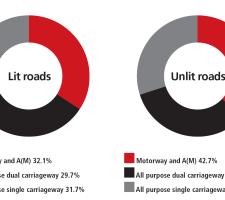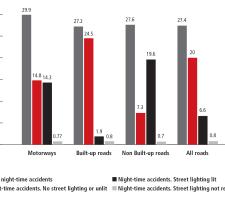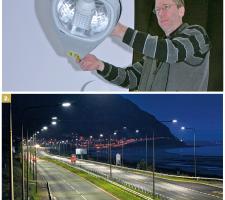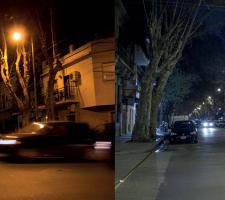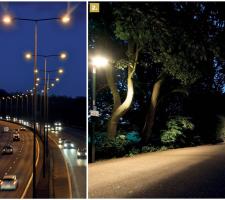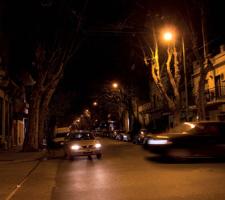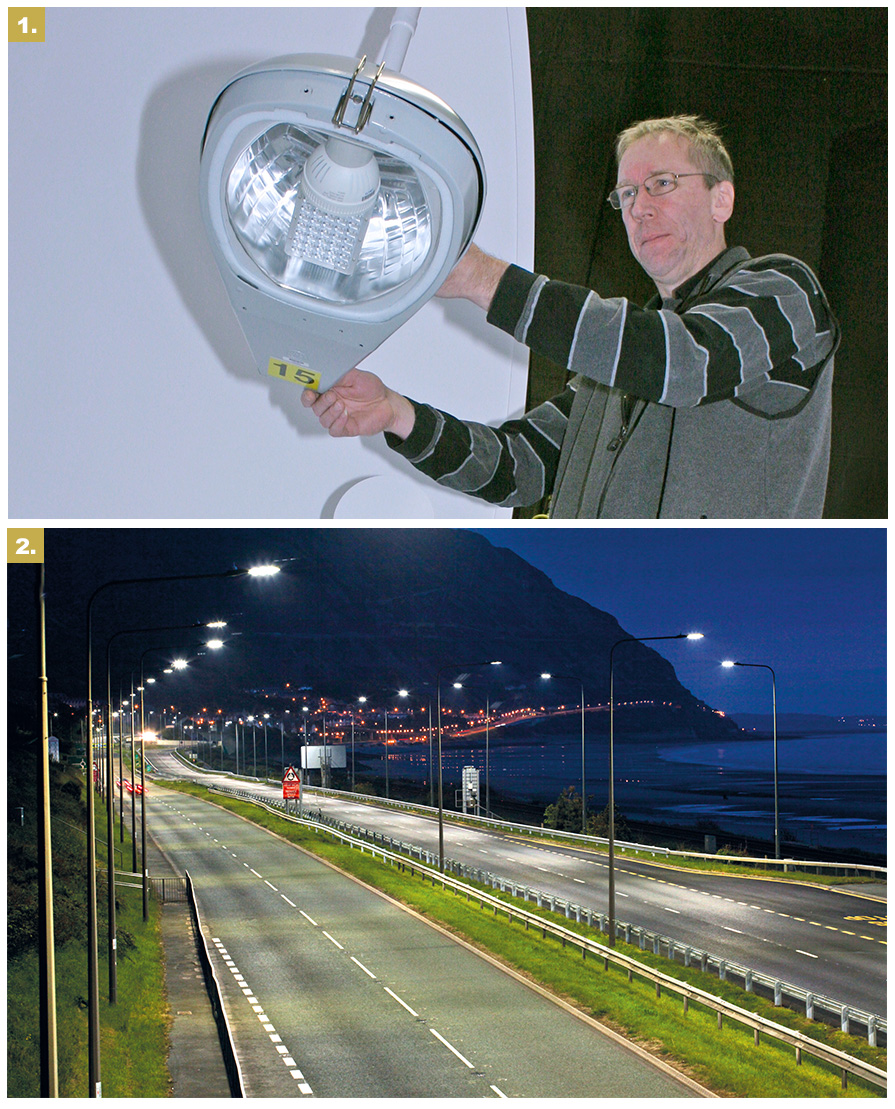
Street lighting can account for 40% of an authority’s energy consumption. So, faced with the need to reduce outgoings, some authorities are looking for smart ways of managing street lighting or even turning off swathes of street lights in the small hours.
Back in 2008 the E-street Initiative report concluded that authorities across Europe could reduce their street lighting energy bills by an average of 66% if they were smarter in managing their street lighting. According to the report, almost two thirds of the savings would come from dimming and regulating lighting levels with the remainder coming from replacing older installations.
At that time the global economic crisis was in full swing and all optional expenditure was stopped – even if it would lead to longer term savings. In many areas those restrictions have eased slightly, allowing authorities to consider expenditure that makes longer term savings in both expenditure and, increasingly important, carbon emissions.
Increases in energy prices have pushed street lighting further up the agenda and nowhere more so than in the UK where the government’s Carbon Reduction Energy Efficiency Scheme was extended in April 2014 to include street lighting and imposes an initial £16 surcharge for every tonne of CO2 produced in creating the energy each authority consumes.
That does not change the fact that on the roads, darkness is a killer. According to the UK’s Automobile Association (
The general consensus is that street lighting can reduce night-time accidents by 30% on residential roads while for motorways where there are no pedestrians and cyclists, figures from the
To simply turn off the lights without due consideration and risk analysis could mean an authority does not fulfil its statutory requirements and leaves itself open to legal challenges in the event of an accident. Happily, the latest technologies do provide some solutions to this conundrum.
One of the easiest energy reducing measures to implement is to fit low energy luminaires such as florescent tubes or light emitting diodes (LEDs) in place of traditional units.
Between 2000 and 2014, the efficiency of LEDs increased by a factor of 10 and costs have fallen, so their consumption can now be lower than that of florescent tubes (although the housing may be more expensive) and they also offer a longer service life. Some companies now market direct LED-based replacements for high-intensity discharge lamps while others offer the complete LED luminaries.
According to Allan Howard of consultants
He said: “Traditional light sources such as sodium can take 10 to 15 minutes to warm up before they give full illumination whereas LEDs produce their maximum light output from the moment they are turned on. So you can re-program the sensors to turn on LED lamps as the ambient light drops towards the specified level rather than 15 minutes earlier – which at dusk in the winter, when factories are still working, is the most expensive time to consume electricity.”
In many parts of the world the required lighting level along a roadway is dictated by volume of traffic using the road, and in many instances those responsible use the average traffic figures to calculate the required lighting level. But as pointed out by the AA, if only a quarter of car journeys are made between 7pm and 8am, then the average volume is not indicative of the night-time traffic.Solar power
Solar powered street lighting is an attractive proposition – no cabling, electricity bills or carbon emissions - but technical and practical considerations limit where they can provide the required levels of illumination throughout the hours of darkness. In many instances the solar array and energy storage needed to meet the required illumination level may be too large and expensive to be viable.
But the inclusion of a system to dim or switch off the light when there is little traffic and no pedestrians or cyclists around, may conserve enough energy to provide the appropriate level of lighting when required. This additional technology will increase the unit cost and could potentially negate one of the key benefits – that of not requiring cabling, but it could also provide a solution in remote area.
Howard: “When authorities look at the actual traffic flows between peak flow hours at night they often find the illumination required is one or even two levels below what they are currently providing, so if regulations permit, the lighting levels can be reduced.”
Although the reduction in energy usage will be proportionately less than the reduction in illumination, as many street lights are in operation for more than 4,000 hours per year, any reduction can pay dividends.
Such considerations were taken into account in 2007 when the UK’s lighting requirements were revised and the Highways Agency reviewed the existing provisions across the motorway network. This identified several stretches of motorway which no longer met the criteria requiring lighting throughout the hours of darkness.
So in April/May 2009, following individual safety assessments, the lights along six sections of motorway (totalling 28.5km/17.7 miles) were turned off between midnight and 5am. In 2010/11 the lighting on a further eight sections of motorway (totalling 77km/44 miles) was turned off between midnight and 6am. All these lights can be turned on again if an incident occurs.
A spokesperson for the Highways Agency said: “Evidence so far [from the first six sites] indicates that switching off the lights between the hours of midnight and 5am on carefully selected sections of motorway hasn’t had an adverse impact on safety.”
In the five years before the switch off there was an average of five accidents per year across the selected stretches whereas in the two years following the switch off (the latest data available) the average has been 4.9. That said, statistically the fatality rate is slightly higher rising from an average of 0.4 per year to 0.8 after the switch offs started. The agency said statistically the numbers are too small for meaningful analysis; any changes could reflect random chance variation and conclusions can only be drawn after the full three or five years.
Available data suggests that turning the lights off has not had an impact on the volume and speed of early morning traffic.
Where legislation permits, even bigger savings can be made not turning the existing lights on at all if actual traffic levels are below threshold values and here again the UK’s Highways Agency has experience. Between March 2011 and October 2012 it implemented the permanent switch off of lighting along eight stretches of motorway totalling 95km (59 miles).
Its spokesperson said: “This is not about wishing to remove all lights from the motorway network. It’s about carefully identifying the locations where, under the guidelines that were revised in 2007, we would not consider installing lighting.”
Traffic on other roads also falls dramatically over night and in particular locations, such as Dark Sky areas, turning lights off can be desirable but may not be acceptable as it could increase risk at an area where there is an existing road hazard. For such circumstances a traffic sensing solution that turns the lights on as vehicles approach and off again after they have departed may provide an ideal solution and is another advantage of LEDs and fluorescent tubes over high and low pressure sodium.
Radar-based system supplier AGD Systems provided one such system at a roundabout close to the World Heritage site at Stonehenge in England.
On smaller roads, cycle ways and footpaths the local authority may be tempted to turn the lights off late at night as the number of users falls but that can heighten public concern about road safety and crime. As Howard points out, perception is often the biggest obstacle for many users: “Potential users are reluctant to use an unlit cycle way or footpath even if they know the lights will come on once they have started.”
Far better, he said, to dim the lights rather than extinguish them all together and to restore full intensity when a user is detected. “The energy savings will be lower with dimming but there is no point in creating segregated paths if people are put off using them at night because they feel the lighting is in some way inadequate.”
Several companies are marketing systems that dim lights when there is little or no moving traffic, and restore the lighting level as people or vehicles move through the area before dimming them again once they have passed. AGD said this can be achieved by instrumenting every sixth to tenth lighting column and can provide substantial energy savings while retaining illumination on the road, which reassures the public and mitigates liability in the event of an accident.
While it is possible to differentiate between vehicles and pedestrians/cyclists and adjust the lighting levels accordingly, AGD said the additional costs would not be justified in all circumstances.Companies such as wireless monitoring and control system specialist
Competing lighting needs are a constant theme and after conservationists found species of rare bats living in the area, the Warren Footpath alongside the River Thames in Richmond became a prime example. Light from the existing installations along the path was spilling across the surrounding trees (where the bats roost) and parts of the river which restricted their feeding areas. Initial plans to remove all the lights from the footpath were rejected by local residents so Richmond Council worked with
Furthermore, by incorporating a motion sensing system, the LEDs can be dimmed to 20% when the path is not being used and brought back to full illumination as a person approaches. In order to maximise public confidence, the sensors communicate with adjacent lamps so the illumination level is increased ahead of those walking the path and dimmed some way behind them.
Savings and maintenance
Even small-scale changes to street lighting can produce substantial cost savings. By switching off the lights along less than 3% of the UK motorway network (not all of which is lit), the Highways Agency achieved annual savings in excess of £400k in 2012/13. In terms of carbon equivalent savings from both partial and total switch offs, the 2009/10 figure was calculated at 402tonnes rising to 3,106tonnes in 2011/12.Across in Argentina, the authority in Buenos Aires halved the energy consumed by street lighting after it commissioned Philips to replace 70% of the city’s street lighting (91,000 lights) with LED-based luminaires. The company also installed its CityTouch telemanagement platform allowing the authority to dim or switch off individual luminaires and monitor their operation for maintenance and replacement programming purposes.
As the service life of LEDs is around five times longer than for conventional lighting the maintenance requirements on converted street lighting is correspondingly lower. So much lower that some believe the traditional management centres set up to detect, report and rectify street lighting faults may no longer be required.
However, with the increasing use of adaptive lighting, management centres could provide a way of monitoring energy usage as many street light systems are not directly metered.
Low energy lighting is equally applicable for illuminating signs or bollards and while the potential savings are relatively low, the increased reliability and extended service intervals remain an attractive proposition.
As both financial and carbon emissions savings can be made by converting to smart, low energy street lighting, there is a wide variety of sources available to authorities needing to fund the switch-over including favourable terms from those lending to environmentally-beneficial projects.
So street lighting really can be a win-win for authorities: cutting direct and maintenance costs as well as helping meet carbon reduction targets.
LIGHTING INSTITUTE
Only four of seven LED-based replacements for high-intensity discharge (HID) ‘Mogul’ lamps tested by the Lighting Research Centre (LRC) at the Rensselaer Polytechnic Institute in New York, met the minimum criteria for roadway luminaires retrofit kits.
There are an estimated 144 million Mogul base HID lamps in the US (with E39/E40 fittings that typically range from 150W to 1,000W) and around half of which are the high pressure sodium versions used in illuminating roadways and parking lots. While they represent only 2% of the installed lamp inventory in the US, HIDs consume 26% of the nation’s lighting energy although the report found retrofitting from HID to LED was only likely to yield energy savings in a relatively small number of units.
LRC characterised and photometric tested a representative 18 (of 194) Mogul base HID equivalent replacements LED lamps, both separately and in HID lamp luminaires, in order to develop a testing plan that ensures application equivalency. Only four of the seven marketed as HID replacements in street roadway and parking lot lighting applications were found to meet the DesignLights Consortium Qualified Products List’s minimum criteria for roadway luminaires retrofit kits.
LRC also conducted a survey of specifiers’ key considerations when selecting lamp and luminaire performance characteristics (light output, intensity distribution and size) for various lighting applications to develop a performance testing plan for a second phase which is now underway. A proposed third phase would consist of field demonstrations to determine real-world performance and acceptability.
• The full report is available here
A55 COMPARISON
To enable the North & Mid Wales Trunk Road Agent to select the most appropriate lighting for a project on the A55, manufacturer CU Phosco Lighting designed three lighting scheme options. These considered illumination, energy use and maintenance requirements of the existing high pressure sodium 150W and 250W lanterns and CU Phosco’s P850 main road LED lantern at both ME2 and a dimmed ME3a lighting class.
The existing lighting columns were to be retained so the specification was for a lightweight, low wind area lantern providing lighting to class ME2. There was also the opportunity for the lighting to be dimmed (via the central management system) to lighting class ME3a between midnight and 6am when traffic flows are low. Furthermore, high traffic flows in the summer holiday season restrict when maintenance and repair work can be carried out.
A total cost of ownership calculation compared investment costs and energy consumption for the 250W sodium (302W total consumption) and the P850 LED (rated at 190W for ME2 and 118W at ME3a) options were calculated over 24 years.
The calculation considers carbon emissions tax, the current kWh energy cost, maintenance costs (exc traffic management), product investment and reduced energy dimming.
Maintenance was determined as a five year replacement cycle for the sodium lamps compared with cleaning of the LED glass every six years during the mandatory electrical inspection.
The assessment showed the P850 would meet the specification and at the current energy prices would repay the additional investment cost for LED conversion within four years.
The LED lanterns were programmed to the lighting design power levels and are dimmable via integral central management system controls. The limited number of variants simplified specification and installation.
The resulting system provides energy savings of 38% in normal operation and 59% when dimmed while retaining the ability to adjust the lighting level in accordance with the traffic flow.


